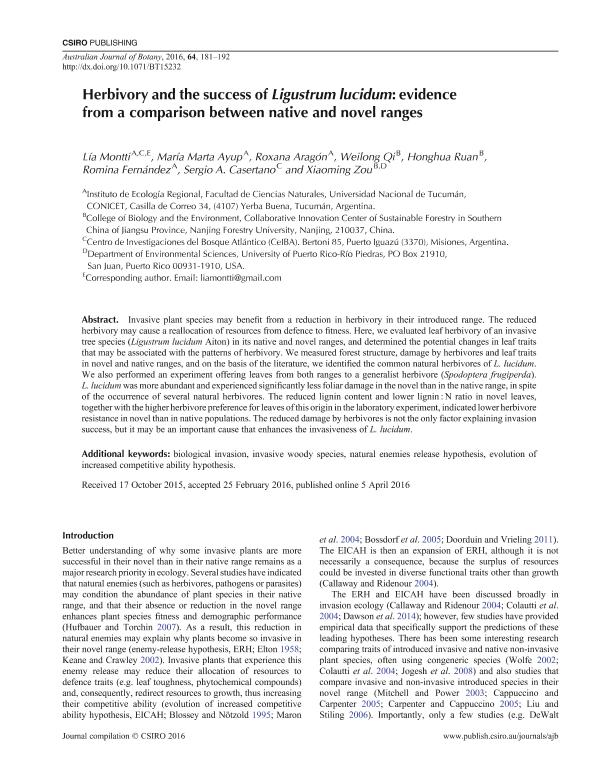Mostrar el registro sencillo del ítem
dc.contributor.author
Montti, Lia Fernanda

dc.contributor.author
Ayup, María Marta

dc.contributor.author
Aragón, Myriam Roxana

dc.contributor.author
Weilong, Qi
dc.contributor.author
Honghua, Ruan
dc.contributor.author
Fernandez, Romina Daiana

dc.contributor.author
Casertano, Sergio A.
dc.contributor.author
Xiaoming, Zou
dc.date.available
2018-09-04T15:39:45Z
dc.date.issued
2016-04
dc.identifier.citation
Montti, Lia Fernanda; Ayup, María Marta; Aragón, Myriam Roxana; Weilong, Qi; Honghua, Ruan; et al.; Herbivory and the success of Ligustrum lucidum: Evidence from a comparison between native and novel ranges; Csiro Publishing; Australian Journal of Botany; 64; 3; 4-2016; 181-192
dc.identifier.issn
0067-1924
dc.identifier.uri
http://hdl.handle.net/11336/58215
dc.description.abstract
Invasive plant species may benefit from a reduction in herbivory in their introduced range. The reduced herbivory may cause a reallocation of resources from defence to fitness. Here, we evaluated leaf herbivory of an invasive tree species (Ligustrum lucidum Aiton) in its native and novel ranges, and determined the potential changes in leaf traits that may be associated with the patterns of herbivory. We measured forest structure, damage by herbivores and leaf traits in novel and native ranges, and on the basis of the literature, we identified the common natural herbivores of L. lucidum. We also performed an experiment offering leaves from both ranges to a generalist herbivore (Spodoptera frugiperda). L. lucidum was more abundant and experienced significantly less foliar damage in the novel than in the native range, in spite of the occurrence of several natural herbivores. The reduced lignin content and lower lignin:N ratio in novel leaves, together with the higher herbivore preference for leaves of this origin in the laboratory experiment, indicated lower herbivore resistance in novel than in native populations. The reduced damage by herbivores is not the only factor explaining invasion success, but it may be an important cause that enhances the invasiveness of L. lucidum.
dc.format
application/pdf
dc.language.iso
eng
dc.publisher
Csiro Publishing

dc.rights
info:eu-repo/semantics/openAccess
dc.rights.uri
https://creativecommons.org/licenses/by-nc-sa/2.5/ar/
dc.subject
Biological Invasion
dc.subject
Evolution of Increased Competitive Ability Hypothesis.
dc.subject
Invasive Woody Species
dc.subject
Natural Enemies Release Hypothesis
dc.subject.classification
Otras Ciencias Biológicas

dc.subject.classification
Ciencias Biológicas

dc.subject.classification
CIENCIAS NATURALES Y EXACTAS

dc.title
Herbivory and the success of Ligustrum lucidum: Evidence from a comparison between native and novel ranges
dc.type
info:eu-repo/semantics/article
dc.type
info:ar-repo/semantics/artículo
dc.type
info:eu-repo/semantics/publishedVersion
dc.date.updated
2018-08-28T13:34:50Z
dc.journal.volume
64
dc.journal.number
3
dc.journal.pagination
181-192
dc.journal.pais
Australia

dc.journal.ciudad
Collingwood
dc.description.fil
Fil: Montti, Lia Fernanda. Universidad Nacional de Tucumán. Instituto de Ecología Regional. Consejo Nacional de Investigaciones Científicas y Técnicas. Centro Científico Tecnológico Conicet - Tucumán. Instituto de Ecología Regional; Argentina. Centro de Investigaciones del Bosque Atlántico; Argentina
dc.description.fil
Fil: Ayup, María Marta. Universidad Nacional de Tucumán. Instituto de Ecología Regional. Consejo Nacional de Investigaciones Científicas y Técnicas. Centro Científico Tecnológico Conicet - Tucumán. Instituto de Ecología Regional; Argentina
dc.description.fil
Fil: Aragón, Myriam Roxana. Universidad Nacional de Tucumán. Instituto de Ecología Regional. Consejo Nacional de Investigaciones Científicas y Técnicas. Centro Científico Tecnológico Conicet - Tucumán. Instituto de Ecología Regional; Argentina
dc.description.fil
Fil: Weilong, Qi. Nanjing Forestry University; China
dc.description.fil
Fil: Honghua, Ruan. Nanjing Forest University; China
dc.description.fil
Fil: Fernandez, Romina Daiana. Universidad Nacional de Tucumán. Instituto de Ecología Regional. Consejo Nacional de Investigaciones Científicas y Técnicas. Centro Científico Tecnológico Conicet - Tucumán. Instituto de Ecología Regional; Argentina
dc.description.fil
Fil: Casertano, Sergio A.. Centro de Investigaciones del Bosque Atlántico (ceiba); Argentina
dc.description.fil
Fil: Xiaoming, Zou. Universidad de Puerto Rico; Puerto Rico. Nanjing Forest University; China
dc.journal.title
Australian Journal of Botany

dc.relation.alternativeid
info:eu-repo/semantics/altIdentifier/doi/https://dx.doi.org/10.1071/BT15232
dc.relation.alternativeid
info:eu-repo/semantics/altIdentifier/url/http://www.publish.csiro.au/bt/BT15232
Archivos asociados
